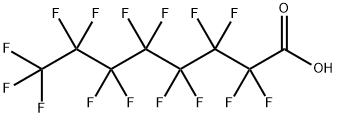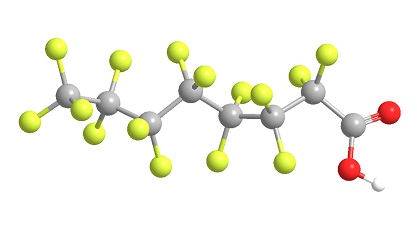
Пентадекафтороктановая кислота
- английское имяPentadecafluorooctanoic acid
- CAS №335-67-1
- CBNumberCB4256038
- ФормулаC8HF15O2
- мольный вес414.07
- EINECS206-397-9
- номер MDLMFCD00004174
- файл Mol335-67-1.mol
| Температура плавления | 55-56 °C (lit.) |
| Температура кипения | 189 °C/736 mmHg (lit.) |
| плотность | 1,7 g/cm3 |
| Fp | 189-192°C |
| температура хранения | 2-8°C |
| растворимость | 3.4g/l |
| форма | Crystalline Powder |
| пка | 0.50±0.10(Predicted) |
| Удельный вес | 1.7 |
| цвет | White |
| РН | 2.6 (1g/l, H2O, 20℃) |
| Растворимость в воде | 3.4 g/L |
| БРН | 1809678 |
| Стабильность | Stable. Incompatible with bases, oxidizing agents, reducing agents. |
| ИнЧИКей | SNGREZUHAYWORS-UHFFFAOYSA-N |
| Справочник по базе данных CAS | 335-67-1(CAS DataBase Reference) |
| Рейтинг продуктов питания EWG | 8 |
| FDA UNII | 947VD76D3L |
| Предложение 65 Список | Perfluorooctanoic Acid (PFOA) |
| МАИР | 2B (Vol. 110) 2017 |
| Справочник по химии NIST | Octanoic acid, pentadecafluoro-(335-67-1) |
| Система регистрации веществ EPA | Perfluorooctanoic acid (335-67-1) |
| UNSPSC Code | 85151701 |
| NACRES | NA.24 |
| Коды опасности | C,Xi,T,F | |||||||||
| Заявления о рисках | 22-34-52/53-39/23/24/25-23/24/25-11 | |||||||||
| Заявления о безопасности | 26-36/37/39-45-36/37-16-7 | |||||||||
| РИДАДР | UN 3261 8/PG 3 | |||||||||
| WGK Германия | 2 | |||||||||
| RTECS | RH0781000 | |||||||||
| Примечание об опасности | Corrosive | |||||||||
| TSCA | T | |||||||||
| Класс опасности | 8 | |||||||||
| Группа упаковки | III | |||||||||
| кода HS | 29159080 | |||||||||
| Банк данных об опасных веществах | 335-67-1(Hazardous Substances Data) | |||||||||
| Токсичность | dnd-esc 50 mmol MUREAV 89,95,81 | |||||||||
| NFPA 704: |
|
рисовальное письмо(GHS)
-
рисовальное письмо(GHS)



-
сигнальный язык
опасность
-
вредная бумага
H318:При попадании в глаза вызывает необратимые последствия.
H372:Поражает органы в результате многократного или продолжительного воздействия.
H302+H332:Вредно при проглатывании или при вдыхании.
H351:Предполагается, что данное вещество вызывает раковые заболевания.
H360D:Может отрицательно повлиять на неродившегося ребенка.
H362:Может причинить вред детям, находящимся на грудном вскармливании.
-
оператор предупредительных мер
P260:Не вдыхать газ/ пары/ пыль/ аэрозоли/ дым/ туман.
P263:Избегать контакта в период беременности и грудного вскармливания.
P280:Использовать перчатки/ средства защиты глаз/ лица.
P304+P340+P312:ПРИ ВДЫХАНИИ: Свежий воздух, покой. Обратиться за медицинской помощью при плохом самочувствии.
P305+P351+P338:ПРИ ПОПАДАНИИ В ГЛАЗА: Осторожно промыть глаза водой в течение нескольких минут. Снять контактные линзы, если Вы ими пользуетесь и если это легко сделать. Продолжить промывание глаз.
P308+P313:ПРИ подозрении на возможность воздействия обратиться за медицинской помощью.
Пентадекафтороктановая кислота химические свойства, назначение, производство
Описание
Concerns about the potential environmental and toxicological impacts of long-chain perfluoroalkyl sulfonates and carboxylic acids have led to: (1) the phaseout of production of perfluorooctane sulfonate (PFOS) and related compounds and perfluorooctanoic acid (PFOA) by their major global manufacturer in 2000–02; (2) the conclusion of a stewardship agreement between the United States Environmental Protection Agency (US EPA) and eight leading global companies to reduce emissions and product content of PFOA and related chemicals by 95% by 2010 and to work toward their elimination by 2015; (3) a similar agreement between the Canadian environmental and health authorities and five companies to restrict perfluorinated carboxylic acids in products; (4) a European Union Marketing and Use Directive restricting the use of ‘PFOSs’ in the European Union; and (5) the inclusion of PFOS in the Stockholm Convention on Persistent Organic Pollutants as an Annex B substance, i.e., restricted in its use; and other regulatory and voluntary initiatives intended to reduce environmental emissions of this family of compounds.Химические свойства
Perfluorooctanoic acid is a white to off-white powder or colorless flakes. It is very soluble in water.It has a pH of 2.6. Perfluorooctanoic acid has the ability to react with bases, oxidizing agents, and reducing agents. Upon decomposition, PFOA can form carbon oxides and hydrogen fluoride. Additional information related to physical and chemical properties of PFOA are not currently available.
Использование
Perfluorooctanoic acid (PFOA) is fluorinated surfactant used, primarily as its ammonium salt (APFO), as an aid in the chemical synthesis of fluoropolymers and fluoroelastomers. As such, it may be found in nonstick cookware and utensils, stain-repellant fabric treatments, and water-proofing treatments for garments. Although an effort is underway by the U.S. EPA to reduce use of and replace perfluoroalkyls with other substances, PFOA is still used in United States industry.Perfluorooctanoic acid (PFOA, C8, pentadecafluorooctanoic acid, perfluoro caprylic acid) is an eightcarbon compound in the perfluoroalkyl family of chemicals. Perfluorooctane sulfonate is used in a variety of applications, including nonstick cookware, waterproof clothing, leather products, cleaning products, and pesticides. Its main use was as a stain repellent on carpet, furniture, and other consumer products. In 2006, the U.S. Protection Agency along with eight major companies that utilized PFOA embarked on a program to reduce emissions and use of the chemical by 2015 (USEPA, 2012).
Определение
ChEBI: A fluoroalkanoic acid that is perfluorinated octanoic acid.Общее описание
Perfluorooctanoic acid is a perfluoroalkyl acid commonly used in the preparation of fluoroacrylic esters, fluoropolymers and fluoroelastmers. It is found to be environmentally persistent and bioaccumulative with a long half-life.Профиль безопасности
Poison by intraperitoneal route. Mutation data reported. Whenheated to decomposition it emits toxic vapors of Fí.Экологическая судьба
Perfluorooctanoic acid found in the environment may result from waste stream releases from manufacture of cosmetics, lubricants, paints, polishes, adhesives, fabric treatments, and fire-fighting compounds. It can partition to the vapor phase in the atmosphere, where it is degraded atmospherically with a half-life of 31 days. It is very resistant to hydrolysis, and immobile in soil. It will not likely evaporate from soil (depending on soil pH) or surface waters. It is not expected to be absorbed to sediments and suspended particles. Perfluorooctanoic acid is not expected to bioaccumulate in aquatic organisms (BCF =3.1–9.4) (NLM, 2013).Методы очистки
Crystallise the acid from CCl4 and toluene, and distil it. It forms micelles in H2O and the solubility is 1% in H2O. The acid chloride has b 129-130o/744mm. The amide has m 138o. [Bernett & Zisman J Phys Chem 63 1911 1959, Bro & Sperati J Polym Sci 38 289 1959, Beilstein 2 IV 994.]Пентадекафтороктановая кислота запасные части и сырье
сырьё
запасной предмет
- perfluoro octylamine acid salt
- Поли (винилиденфторид)
- POLY(CHLOROTRIFLUOROETHYLENE-CO-VINYLIDE NE FLUORIDE) 26 MOLE% VINYLIDENE FLUORI
- Гептафтормасляная кислота
- Этиловый перфтороктаноа
1of3
Пентадекафтороктановая кислота поставщик
| поставщик | телефон | страна | номенклатура продукции | благоприятные условия | |
|---|---|---|---|---|---|
| +86-027-85613400 +86-15827173649 |
China | 178 | 58 | ||
| +8615531157085 | China | 8804 | 58 | ||
| +86 13288715578 +8613288715578 |
China | 12825 | 58 | ||
| +86-13131129325 | China | 5887 | 58 | ||
| +86-371-86557731 +86-13613820652 |
China | 20259 | 58 | ||
| +8613343047651 | China | 3692 | 58 | ||
| +86-371-66670886 | China | 19902 | 58 | ||
| +86-0371-55170693 +86-19937530512 |
China | 21632 | 55 | ||
| +86-0571-85586753; +8613336034509 |
China | 1376 | 60 | ||
| +86-0371-86658258 +8613203830695 |
China | 29871 | 58 |